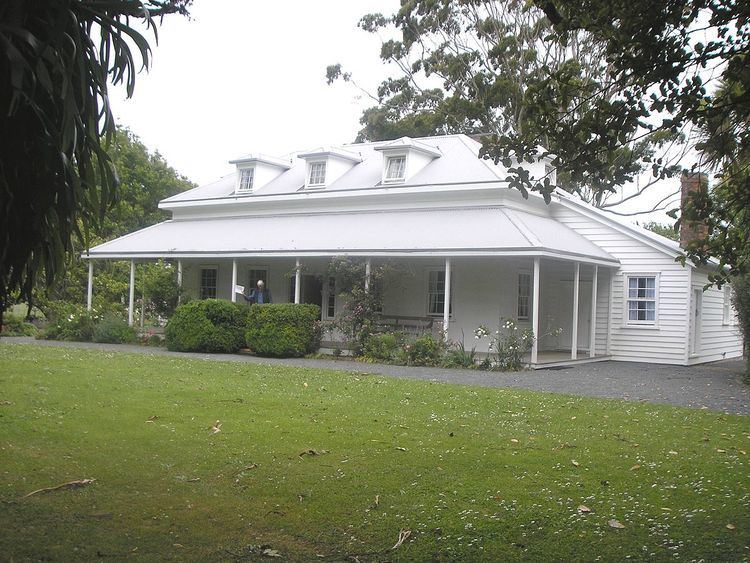Phone +64 9-405 9734 | ||
 | ||
Address 344 Te Ahu Ahu Rd, Waimate 0472, New Zealand Hours Open today · 10AM–5PMTuesday10AM–5PMWednesdayClosedThursdayClosedFriday10AM–5PMSaturday10AM–5PMSunday10AM–5PMMonday10AM–5PMSuggest an edit Similar Mission House, Stone Store, Clendon House, Pompallier House, Ruapekapeka | ||
Te waimate mission book conservation
Te Waimate Mission was the fourth mission station established in New Zealand and was the first settlement inland from the Bay of Islands. The members of the Church Missionary Society (CMS) appointed to establish Te (the) Waimate Mission at Waimate North were the Rev. William Yate and the lay members of the CMS were: Messrs. Richard Davis, George Clarke and James Hamlin.
Contents
- Te waimate mission book conservation
- Te waimate mission house
- The early years of Te Waimate Mission
- St John the Baptist Church
- List of clergymen 1830 1884
- List of Archdeacons 1830 1901
- St Johns College at Te Waimate Mission
- Te Waimate Mission after 1845
- CMS members appointed to Te Waimate Mission
- References
Te waimate mission house
The early years of Te Waimate Mission
At the instigation of Samuel Marsden, a model farming village for the Māori was constructed at Te Waimate by the Church Missionary Society (CMS). Land was bought from the Ngāpuhi tribe following the Girls' War of 1830.
In 1830, Richard Davis, a farmer and lay member of the CMS, established a farm at the Waimate Mission.
In 1835 William Williams, Jane and their family move to Waimate, where Williams continued his work on the translation of the Bible into Māori. The boarding school for the sons of the CMS missionaries was also transferred from Paihia to Te Waimate Mission. Richard Taylor succeeded William Williams as principal of the Waimate Boys’ School in September 1839.
On 23 & 24 December 1835 Charles Darwin visited when HMS Beagle spent 10 days in the Bay of Islands.
The village comprised three wooden houses for missionary families, a flour mill, printery, carpenters' shop, brickworks, blacksmith, school and of course the church. Marsden hoped Māori would be educated into European culture while making Te Waimate Mission a paying proposition by producing goods for sale to European shipping and the local Māori through the Stone Store at Kerikeri. The attempt to impose European culture on Māori in a controlled fashion where those being taught also formed the labour, failed to attract many Māori and the station was gradually run down.
St. John the Baptist Church
The construction of the church at Te Waimate was commenced in May 1831 and it was completed in 6 weeks. The name of the church was chosen as St. John the Baptist day fell on June 24. The original church also served as a school room.
The first child baptised was Edward Blomfield Clarke on 10 July 1831. The first marriage of two Europeans in New Zealand was conducted on 11 October 1831, between William Gilbert Puckey (26), son of a CMS carpenter, William Puckey, and Matilda Elizabeth Davis (17), second daughter of the Rev. Richard Davis.
The existing St. John the Baptist Church was built in 1871.
List of clergymen (1830-1884)
The clergymen appointed to St. John the Baptist Church were:
In 1884 the CMS gave control over the church to the Diocesan Trust Board.
List of Archdeacons (1830-1901)
Bishop George Selwyn appointed the Rev. Henry Williams as Archdeacon of Te Waimate on 21 September 1844.
St. John’s College at Te Waimate Mission
In June 1842 Bishop George Selwyn set up residence at Te Waimate Mission. Some buildings were converted for use by St. John’s College to teach theology to candidates for ordination into the Anglican Church. The candidates for ordination were:
On 26 September 1844 Bishop Selwyn presided over the first Synod held in New Zealand. Later in 1844 Bishop Selwyn moved his residence and St John’s College to Auckland.
Te Waimate Mission after 1845
During the Flagstaff War casualties of the Battle of Ohaeawai (July 1845) were buried in the graveyard of St. John the Baptist church. The mission station was used as the headquarters for the British army from 15 June 1845 to 6 October 1845, after which the mission lost support among the Māori. The mission station gradually fell into disrepair and the buildings were subsequently put up for sale.
Today the only remnant on the site is the house originally occupied by George Clarke, which is preserved by Heritage New Zealand as a museum. One of the other houses survives at the Butler Point Whaling Museum.
CMS members appointed to Te Waimate Mission
The members of the Church Missionary Society who were appointed to Te Waimate Mission include:
